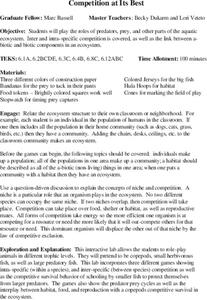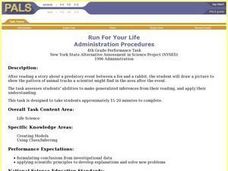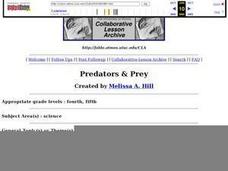Curated OER
Who's Coming to Dinner?
Students identify the role predators/prey play in food chains, differentiate between food chains and webs, identify factors that affect the balance in food webs, and propose solutions to protect endangered species' environments and...
Curated OER
What Makes up an Ecosystem?
Eighth graders design posters of working ecosystems using pictures from magazines. They label autotrophic, heterotropic, or saprotrophic energy sources, and identify predators and prey.
Curated OER
Predator-Prey Relationships
Students understand ecological systems. They provide experiences to assist citizens to increase their sensitivity and stewardship for the environment.
Curated OER
Animals Abound
Learners explore the world of mammals, birds, and fish to compare and contrast their habitats, adaptations, and camouflages. Through research, musical experiences, and hands-on activities, the lives and adventures of these animals are...
Curated OER
Predator-Prey Simulation
Learners simulate the interactions between a predator population of lynx and a prey population of rabbits. They collect and graph the data, then extend the graph to predict the populations for several more generations.
Curated OER
Mariposas
Students examine how animals use camouflage for survival. In this investigative lesson students define vocabulary words and see how it is the environment that controls which adaptations will help in survival.
Curated OER
Amusing Animal Adaptations
Students identify how animals adapt characteristics to help them survive or reproduce. In this animal instructional activity, students draw pictures of their animal and adaptation.
Curated OER
Infrared Zoo Lesson 2 Index Dinner in the Dark
Students discover how certain snakes can find prey using a natural infrared sensor. They think about small prey animals and how a pit viper snake finds them in the forest. Students explore the physical characteristics of the animals...
Curated OER
Dull Duck, Dashing Duck
Learners examine the different colors and patterns found on animals bodies, specifically birds. Through discussion, students discover the use of the colors and patterns for protection from predators and the advantages while hunting prey,...
Curated OER
Compettion at its Best
Sixth graders role play predators, prey and other parts of the aquatic ecosystem. They show inter and intra-specific competition as well as the link between abiotic and biotic components in an ecosystem. Students play games about the...
Curated OER
CSI Clamshell Investigation
Learners explore predator/prey relationships. They research information on moon snails and claims. Students draw conclusions from the data collected. They use math and graphing to determine if there is a relationship to the clam's size...
Curated OER
Run For Your Life
Pupils draw a picture of animal tracks a scientist might find after they read a story about a fox chasing a rabbit. They make up a key to represent the foxes' tracks and the rabbit's tracks.
Curated OER
Predator Prey Population Links
Fifth graders relate population of animals to its available food supply. They participate in an experiment and gather information. They use the data to draw conclusions.
Curated OER
Paleoecology of "Fossilized" Owl Pellets
Learners examine fossilized owl pellets to determine how a species environmental preferences allow us to reconstruct probable past environments. Differences in anatomy are used to identify species in this lesson.
Curated OER
Predators & Prey
Young scholars discuss what predators and prey are. Students participate in a playground game aimed at simulating predators and prey.
Curated OER
Birds of Prey
Students explain the predator/prey relationship by researching specific examples of birds (predators) and what they eat to survive (prey).

















